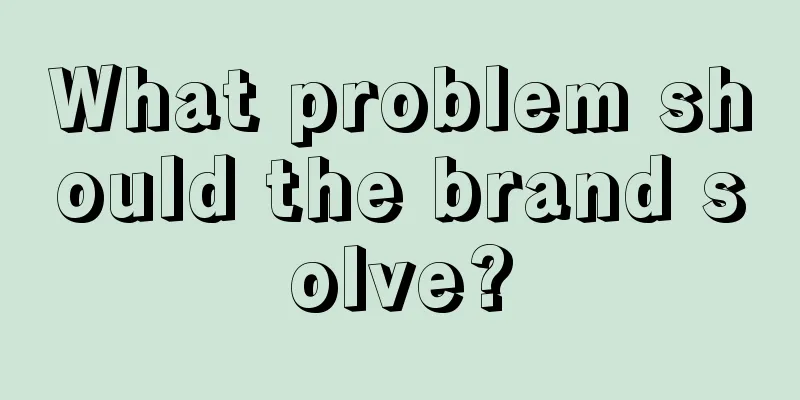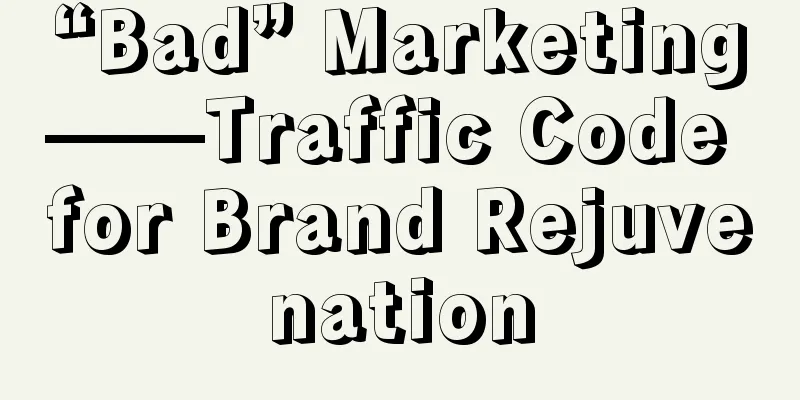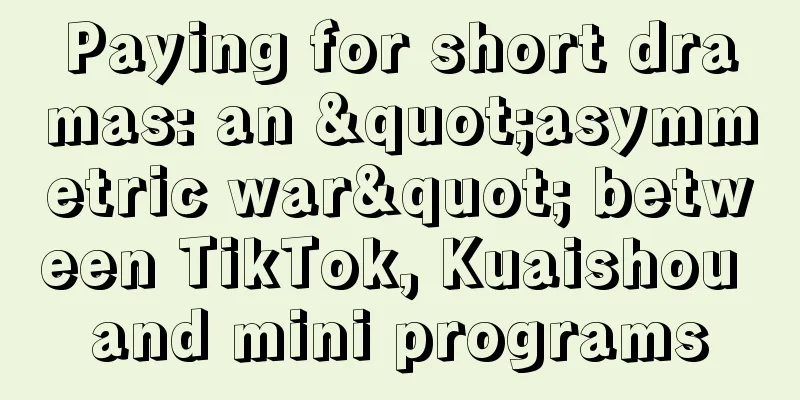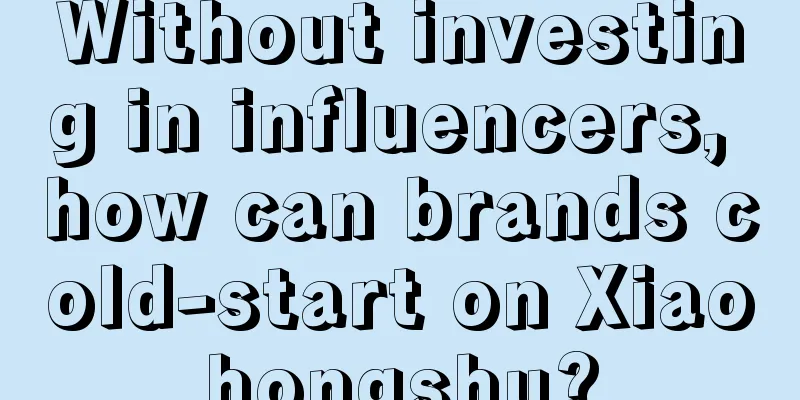What problem should the brand solve?

To explore the essence of something, we must first understand the meaning of its existence. The core of brand is to solve the problem of efficiency, which directly affects the operating efficiency of the enterprise, and operating efficiency is directly related to the business problems of the enterprise. Efficiency can be divided into external and internal aspects. External aspects include communication between brands and users, and recommendations from users to potential users. Internal aspects include organizational collaboration and element integration. 1. ExternalBrand is a bridge for expressing value between enterprises and users, a window for communicating information, and a hook for emotional connection. 1. User understanding efficiencyWhen we do brand consulting, there are three main communication points:
The growth of an enterprise comes from improving efficiency in all links, and it cannot lag behind in the branding link. So, what does it mean to improve the efficiency of user understanding? It means using language that users can "understand better and faster" . Especially for brands facing the general public, it is more necessary to use universal language to express. What does universalization mean? It means it is applicable to the vast majority of ordinary people. Communication effect = expression efficiency x communication budget. The first level of this expression efficiency is to be remembered, and the second level is to be linked to the corporate value proposition, because any purchase comes from value, whether it is functional value or emotional value. With the same communication budget, high expression efficiency can achieve twice the result with half the effort, otherwise you need to spend more budget, which will result in half the result with twice the effort. For example, if you can get users to remember your content after 2 times, but you need to get them to remember it after 6 times, then with the same budget, the effect will be only 1/3 of the original. This can be understood by the car's drag coefficient. Under the same conditions, the smaller the drag coefficient, the faster the acceleration from 0 to 100 km/h. If the drag coefficient is higher and you want to run at the same speed, you need more power. When I was in charge of the strategy department, the principle of producing communication language was "one sentence, no explanation, everyone understands, and highly relevant" . Throw this sentence out there without any extra explanation and see if everyone can understand what you mean and whether this meaning is directly related to your value proposition. There are many excellent cases to learn from in this regard, such as JD.com's "fast, good and economical", Alibaba's "making it easy to do business in the world", and Pinduoduo's "buy together to get cheaper prices". The ideal is to create a mobile home and a happy home. 2. Efficiency of user recommendationsIf good products solve the problem of repurchase rate, then user recommendations are an effective way to expand the user base and turn users into our media themselves. By spreading the word from person to person and using ingenuity, we can greatly reduce the cost of acquiring customers and achieve the desired results with little effort. Make users willing to share, and make it easy for users to share. The higher the efficiency of user recommendations, the lower the cost of acquiring customers and the higher the brand favorability. When conceiving each communication script, the difficulty coefficient of word-of-mouth communication must be considered. For example, Pinduoduo’s fragrance is really good, Luckin’s fragrance is really good, Mercedes-Benz’s vertical logo/big logo, ideal refrigerator, color TV and large sofa, the safety of Bull sockets, and its 10 households, 7 use Bull, and KFC’s Crazy Thursday. 2. InternalBrand is a means to undertake corporate strategies and organizational elements, and is a compass and lubricant for collaboration between organizations. 1. Direct generation of internal information of the brand departmentOne of the important means of accumulating brand assets is to maintain consistency. We often find that when many brands upgrade, they lose their soul and become a mess. When establishing this set of standards, the brand department should be the most responsible, as it is the most direct implementation department. At the same time, the founder needs to take charge of the larger aspects of brand strategy, such as mission/vision/values, brand positioning, brand slogan, brand tone, and brand personality. Expand on this basis and avoid arbitrary changes in brand tone due to personnel turnover. 2. Collaboration between the brand department and other departments/ecological chainsIn most companies, various departments are fighting each other, engaging in a tug-of-war over the two key words "grabbing credit" and "taking the blame." Whether the brand department is embarrassed or not mainly depends on two factors. First, the industry attributes. What drives this industry? Whoever drives it has the final say. Whoever sits on the bench is embarrassed. Second, the boss’s style. You can never wake up a person who pretends to be asleep. The boss’s past resume genes determine his tone of work. When your boss says he wants to build a brand, you can think about it a little more: what does your boss understand as a brand? Is it really the same as your understanding? When a brand is difficult to verify or falsify (in fact, it should be prefixed with "difficult to be accurately verified or falsified"), it actually depends more on the logic of the person in charge: "If you believe it, it exists; if you don't believe it, it doesn't exist." In the brand department, we need to strive for resources and voice as much as possible. If we cannot do deductive reasoning, we will do inductive reasoning. If we cannot do data calculation in one step, we will do the decomposition and refinement as much as possible. In any case, we cannot just talk about concepts. In addition, you need to understand the roles and pain points of each department in the company, and fight with the boss for the brand guidelines to be followed at the corporate strategy level. What is the main contradiction, what is the secondary contradiction, and what is the priority. This must be clear, and communication problems are really a big problem. When it comes to collaboration between parallel departments, it can also be regarded as a seemingly "imperial sword". But to be honest, you can't rely too much on your boss. Most of the time you need to take the initiative. I was in the marketing and branding department before, and I often faced the scene of cross-departmental communication and collaboration. I usually look at the company's genes first, and then look at their roles based on what they have done in the past, and most importantly, understand what they do, so that at least there is room for resonance or confidence in fighting, and first use courtesy before force. As a department head, you can’t be too nice, otherwise you will be a nobody. If you are too nice, your boss won’t like you, your subordinates will look down on you, and your department will look down on you. When working with suppliers, brands mainly need to solve the problem of cognitive synchronization (and need to do it quickly). Suppliers act as external brains, and brands need to draw a baseline, what value the brand provides, what tone the brand maintains, and what are the brand's core advantages and main disadvantages. Drawing a line for strategic service providers means setting strategies based on the company's core operating baseline. Draw a circle for creative service providers, what is the space they can play in, and what are the things outside the circle that they must not touch. Establish a four-quadrant decision-making method for public relations, with the horizontal and vertical axes being reasonable and logical. The most reasonable public relations are determined in the reasonable and logical quadrant. ConclusionWhat problems a brand "should" solve is determined by what problems the brand "can" solve. Brand is a window that solves communication problems; brand is an engine that solves integration problems; brand is belief that solves value problems. Author: Zang Feng WeChat public account: Strategist Cangfeng |
<<: The three treasures of middle-aged men: Hupu, What’s Worth Buying, and Autohome
>>: Chiikawa craze among young people: from emojis to "plastic surgery"
Recommend
Is it reliable to recharge Shopee advertising fees? How to recharge Shopee advertising fees?
After we open a store on the Shopee platform, we m...
How long does it take to cancel a Shopee promotion? How to participate in the event?
Some seller friends operate their stores by partic...
Amazon provides aid to communities affected by Hurricane Ian
Amazon recently announced that it has activated it...
Thousands of young people living alone have studied the essence of "eating and fooling around"
Recently, many people have probably seen videos ab...
How to set up Amazon advertising? Detailed steps
Whether it is Taobao, JD.com, Pinduoduo, or Amazon...
How do I verify my Facebook identity if I change my phone? Can I log in with a different phone?
In the modern era of social media, Facebook has be...
How many words are usually used in Amazon manual ads? How to advertise?
In Amazon advertising strategy, manual advertising...
What are the Lazada local store operation skills? Tips sharing
When opening a store on Lazada, you can choose oth...
Why can’t I open Amazon in the country? Analysis of the reasons
Amazon is a cross-border e-commerce platform, and ...
6 steps to turn Xiaohongshu into an efficient new private domain
This article first briefly introduces Xiaohongshu&...
What are the conditions for opening Lazada Super Alliance? What are the promotion methods?
As a Lazada merchant, there are many things you ne...
What kind of PR response do users need?
Based on the recent Huaxizi apology incident, this...
Why do brands that understand marketing love to open "pop-up stores"?
There are more and more "pop-up stores" ...
The price of AI has skyrocketed tenfold, and the toy industry wants to create another Pop Mart
With the continuous advancement of artificial inte...
Rebirth: New opportunities for small and medium-sized businesses on Xiaohongshu
This article analyzes the marketing cases of Xiaoh...









